Related Research Articles

A star is an astronomical object comprising a luminous spheroid of plasma held together by self-gravity. The nearest star to Earth is the Sun. Many other stars are visible to the naked eye at night, but their immense distances from Earth make them appear as fixed points of light. The most prominent stars have been categorised into constellations and asterisms, and many of the brightest stars have proper names. Astronomers have assembled star catalogues that identify the known stars and provide standardized stellar designations. The observable universe contains an estimated 1022 to 1024 stars. Only about 4,000 of these stars are visible to the naked eye, all within the Milky Way galaxy.

X-ray astronomy is an observational branch of astronomy which deals with the study of X-ray observation and detection from astronomical objects. X-radiation is absorbed by the Earth's atmosphere, so instruments to detect X-rays must be taken to high altitude by balloons, sounding rockets, and satellites. X-ray astronomy uses a type of space telescope that can see x-ray radiation which standard optical telescopes, such as the Mauna Kea Observatories, cannot.
Starspots are stellar phenomena, so-named by analogy with sunspots. Spots as small as sunspots have not been detected on other stars, as they would cause undetectably small fluctuations in brightness. The commonly observed starspots are in general much larger than those on the Sun: up to about 30% of the stellar surface may be covered, corresponding to starspots 100 times larger than those on the Sun.

The stellar atmosphere is the outer region of the volume of a star, lying above the stellar core, radiation zone and convection zone.
A flare star is a variable star that can undergo unpredictable dramatic increases in brightness for a few minutes. It is believed that the flares on flare stars are analogous to solar flares in that they are due to the magnetic energy stored in the stars' atmospheres. The brightness increase is across the spectrum, from X-rays to radio waves. Flare activity among late-type stars was first reported by A. van Maanen in 1945, for WX UMa and YZ CMi. However, the best-known flare star is UV Ceti, first observed to flare in 1948. Today similar flare stars are classified as UV Ceti type variable stars in variable star catalogs such as the General Catalogue of Variable Stars.
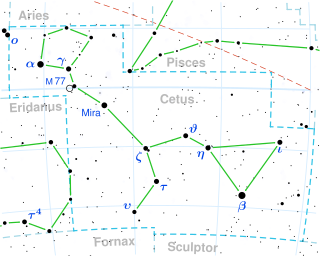
Kappa1 Ceti, Latinized from κ1 Ceti, is a variable yellow dwarf star approximately 30 light-years away in the equatorial constellation of Cetus.

Zeta Cassiopeiae, Latinized from ζ Cassiopeiae, and officially named Fulu, is a variable star in the constellation of Cassiopeia. It has a blue-white hue and is classified as a B-type subgiant with an apparent magnitude of +3.66. Based upon parallax measurements, it is approximately 590 light-years from the Sun.
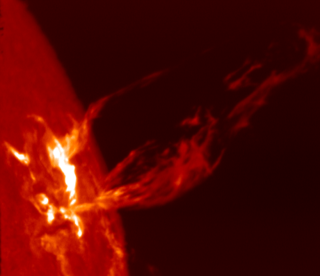
A stellar magnetic field is a magnetic field generated by the motion of conductive plasma inside a star. This motion is created through convection, which is a form of energy transport involving the physical movement of material. A localized magnetic field exerts a force on the plasma, effectively increasing the pressure without a comparable gain in density. As a result, the magnetized region rises relative to the remainder of the plasma, until it reaches the star's photosphere. This creates starspots on the surface, and the related phenomenon of coronal loops.

Stellar rotation is the angular motion of a star about its axis. The rate of rotation can be measured from the spectrum of the star, or by timing the movements of active features on the surface.
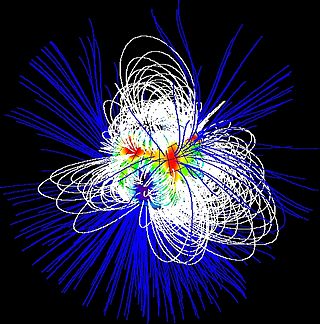
In astrophysics, Zeeman–Doppler imaging is a tomographic technique dedicated to the cartography of stellar magnetic fields, as well as surface brightness and temperature distributions.
Ap and Bp stars are chemically peculiar stars of spectral types A and B which show overabundances of some metals, such as strontium, chromium and europium. In addition, larger overabundances are often seen in praseodymium and neodymium. These stars have a much slower rotation than normal for A and B-type stars, although some exhibit rotation velocities up to about 100 kilometers per second.
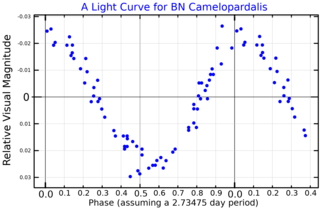
BN Camelopardalis is a suspected astrometric binary in the northern circumpolar constellation of Camelopardalis. It appears as a variable star that is visible to the naked eye as a dim, white-hued point of light with an apparent visual magnitude that fluctuates around 5.49. The system is located at a distance of around 310 light years from the Sun based on parallax, and is drifting further away with a radial velocity of +9 km/s.
Superflares are very strong explosions observed on stars with energies up to ten thousand times that of typical solar flares. The stars in this class satisfy conditions which should make them solar analogues, and would be expected to be stable over very long time scales. The original nine candidates were detected by a variety of methods. No systematic study was possible until the launch of the Kepler space telescope, which monitored a very large number of solar-type stars with very high accuracy for an extended period. This showed that a small proportion of stars had violent outbursts, up to 10,000 times as powerful as the strongest flares known on the Sun. In many cases there were multiple events on the same star. Younger stars were more likely to flare than old ones, but strong events were seen on stars as old as the Sun.

Magnetic braking is a theory explaining the loss of stellar angular momentum due to material getting captured by the stellar magnetic field and thrown out at great distance from the surface of the star. It plays an important role in the evolution of binary star systems.

Epsilon Doradus, Latinzied from ε Doradus, is a solitary star located in the southern constellation of Dorado. It is visible to the naked eye with an apparent visual magnitude of 5.11. Based upon an annual parallax shift of 5.68 mas as measured from Earth, it is located roughly 570 light years from the Sun. At that distance, the visual magnitude of the star is diminished by an extinction factor of 0.09 due to interstellar dust.

Tau9 Eridani is a binary star in the constellation Eridanus. It is visible to the naked eye with an apparent visual magnitude of 4.63. The distance to this system can be estimated using the parallax method, which yields a value of roughly 327 light years.
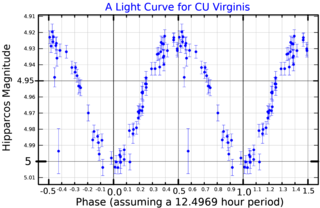
CU Virginis is a single star in the equatorial constellation of Virgo. It has an apparent visual magnitude of 4.99, which is bright enough to be faintly visible to the naked eye. The distance to this star can be estimated from its annual parallax shift of 13.9 mas, yielding a separation of 234 light years.

Xi Phoenicis, Latinized from ξ Phoenicis, is a visual binary star system in the southern constellation of Phoenix. It is faintly visible to the naked eye, having an apparent visual magnitude of 5.70. Based upon an annual parallax shift of 14.61 mas as measured from Earth, it is located around 223 light years from the Sun. The system is moving away from the Sun with a radial velocity of about +10 km/s.
14 Ceti is a single star in the equatorial constellation of Cetus. It is faintly visible to the naked eye under good viewing conditions, having an apparent visual magnitude of 5.84. The distance to 14 Ceti can be estimated from its annual parallax shift of 17.4″, which puts it 187 light years away. It is moving further from the Earth with a heliocentric radial velocity of +11 km/s, having recently come no closer than 178 ly.

The Alfvén surface is the boundary separating a star's corona from the stellar wind defined as where the coronal plasma's Alfvén speed and the large-scale stellar wind speed are equal. It is named after Hannes Alfvén, and is also called Alfvén critical surface, Alfvén point, or Alfvén radius. Parker Solar Probe became the first spacecraft that crossed Alfvén surface of the Sun.
References
- ↑ Highlights of Astronomy, Volume 14; IAU XXVI General Assembly, 14-25 August 2006; Karel A. van der Hucht, ed.; p 285; doi : 10.1017/S1743921307010629
- ↑ D. Moss. Magnetism and Activity of the Sun and Stars J. Arnaud and N. Meunier (eds) EAS Publications Series, 9 (2003) 21 Fossil stellar magnetic fields: do they exist, does it matter?
- ↑ Vincent Duez, Stéphane Mathis, Sylvaine Turck-Chièze. Effect of a fossil magnetic field on the structure of a young Sun